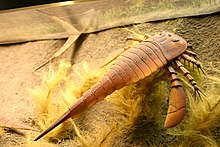
The subphylum Chelicerata constitutes one of the major subdivisions of the phylum Arthropoda. Chelicerates include the sea spiders, horseshoe crabs, and arachnids, as well as a number of extinct lineages, such as the eurypterids and chasmataspidids.

Arachnids are arthropods in the class Arachnida of the subphylum Chelicerata. Arachnida includes, among others, spiders, scorpions, ticks, mites, pseudoscorpions, harvestmen, camel spiders, whip spiders and vinegaroons.

A book lung is a type of respiration organ used for atmospheric gas exchange that is present in many arachnids, such as scorpions and spiders. Each of these organs is located inside an open ventral abdominal, air-filled cavity (atrium) and connects with its surroundings through a small opening for the purpose of respiration.

Eurypterids, often informally called sea scorpions, are a group of extinct arthropods that form the order Eurypterida. The earliest known eurypterids date to the Darriwilian stage of the Ordovician period 467.3 million years ago. The group is likely to have appeared first either during the Early Ordovician or Late Cambrian period. With approximately 250 species, the Eurypterida is the most diverse Paleozoic chelicerate order. Following their appearance during the Ordovician, eurypterids became major components of marine faunas during the Silurian, from which the majority of eurypterid species have been described. The Silurian genus Eurypterus accounts for more than 90% of all known eurypterid specimens. Though the group continued to diversify during the subsequent Devonian period, the eurypterids were heavily affected by the Late Devonian extinction event. They declined in numbers and diversity until becoming extinct during the Permian–Triassic extinction event 251.9 million years ago.

Horseshoe crabs are marine and brackish water arthropods of the family Limulidae and the only living members of the order Xiphosura. Despite their name, they are not true crabs or crustaceans: they are chelicerates, most closely related to arachnids such as spiders, ticks, and scorpions.

Xiphosura is an order of arthropods related to arachnids. They are more commonly known as horseshoe crabs. They first appeared in the Hirnantian. Currently, there are only four living species. Xiphosura contains one suborder, Xiphosurida, and several stem-genera.

Dromopoda is a proposed subclass of the arachnids, including the Opiliones (harvestmen), Scorpions, Pseudoscorpions and Solifugae. The latter three are sometimes grouped as Novogenuata. Combined morphological and molecular analyses have shown Dromopoda to be monophyletic. However, a strictly molecular analysis did not support the monophyly of Dromopoda.

Chasmataspidids, sometime referred to as chasmataspids, are a group of extinct chelicerate arthropods that form the order Chasmataspidida. Chasmataspidids are probably related to horseshoe crabs (Xiphosura) and/or sea scorpions (Eurypterida), with more recent studies suggest that they form a clade (Dekatriata) with Eurypterida and Arachnida. Chasmataspidids are known sporadically in the fossil record through to the mid-Devonian, with possible evidence suggesting that they were also present during the late Cambrian. Chasmataspidids are most easily recognised by having an opisthosoma divided into a wide forepart (preabdomen) and a narrow hind part (postabdomen) each comprising 4 and 9 segments respectively. There is some debate about whether they form a natural group.
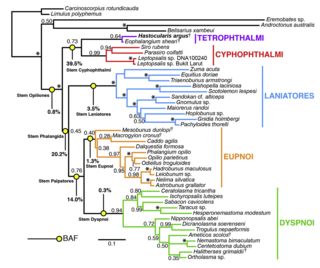
Harvestmen (Opiliones) are an order of arachnids often confused with spiders, though the two orders are not closely related. Research on harvestman phylogeny is in a state of flux. While some families are clearly monophyletic, that is share a common ancestor, others are not, and the relationships between families are often not well understood.
Bunaia is a genus of synziphosurine, a paraphyletic group of fossil chelicerate arthropods. Bunaia was tentatively placed as part of the clade Planaterga. The genus contains at least one species: Bunaia woodwardi from the Silurian period in Svalbard, Norway. Only a few morphological information of B. woodwardi had been confirmed, as the species known only from poorly preserved specimens compose of semicircular carapace, fragments of opisthosoma and disarticulated telson. The placement of "Bunaia" heintzi within this genus had been questioned and required further investigation.
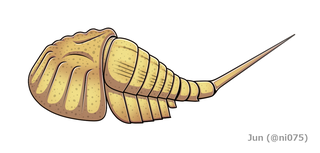
Bunodes is a genus of synziphosurine, a paraphyletic group of fossil chelicerate arthropods. Bunodes was regarded as part of the clade Planaterga. Fossils of the single and type species, B. lunula, have been discovered in deposits of the Silurian period in Ludlow, England. Bunodes is the type genus of the family Bunodidae, the other genera of the same family being Limuloides. There are 64 direct children of Bunodes.

Legrandella is a genus of synziphosurine, a paraphyletic group of fossil chelicerate arthropods. Legrandella was regarded as part of the clade Prosomapoda. Fossils of the single and type species, L. lombardii, have been discovered in deposits of the Devonian period in Cochabamba, Bolivia.

Limuloides is a genus of synziphosurine, a paraphyletic group of fossil chelicerate arthropods. Limuloides was regarded as part of the clade Planaterga. Fossils of the genus have been discovered in deposits of the Silurian period in the United Kingdom and potentially in the United States. Limuloides is one of the two genera of the family Bunodidae, the other being the type genus Bunodes. Limuloides is characterized by a carapace with radiated ridges and serrated lateral regions, and an opisthosoma with rows of nodes. Limuloides was once thought to have lateral compound eyes on its carapace, but later investigation did not find any evidence of it.

Pseudoniscus is a genus of synziphosurine, a paraphyletic group of fossil chelicerate arthropods. Pseudoniscus was regarded as part of the clade Planaterga. Fossils of the genus have been discovered in deposits of the Silurian period in the United Kingdom, the United States and Estonia. Pseudoniscus is one of the two members of the family Pseudoniscidae, the other being Cyamocephalus.

Synziphosurina is a paraphyletic group of chelicerate arthropods previously thought to be basal horseshoe crabs (Xiphosura). It was later identified as a grade composed of various basal euchelicerates, eventually excluded form the monophyletic Xiphosura sensu stricto and only regarded as horseshoe crabs under a broader sense. Synziphosurines survived at least since early Ordovician to early Carboniferous in ages, with most species are known from the in-between Silurian strata.

Tactopoda or Arthropodoidea is a proposed clade of protostome animals that includes the phyla Tardigrada and Euarthropoda, supported by various morphological observations. The cladogram below shows the relationships implied by this hypothesis.
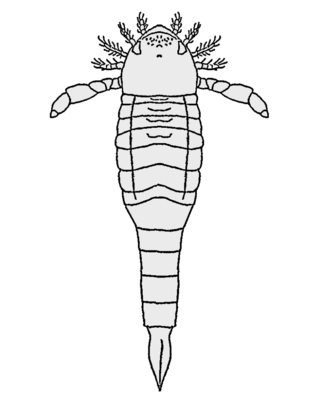
Waeringopteridae is a family of eurypterids, an extinct group of aquatic arthropods. The Waeringopteridae is the only family classified as part of the superfamily Waeringopteroidea, which in turn is classified within the infraorder Diploperculata in the suborder Eurypterina. The earliest known member of the group, Orcanopterus, has been recovered from deposits of Katian age and the latest known surviving member, Grossopterus, has been recovered from deposits of Siegenian age. The name Waeringopteridae is derived from the type genus Waeringopterus, which is named in honor of eurypterid researcher Erik N. Kjellesvig-Waering.

This timeline of eurypterid research is a chronologically ordered list of important fossil discoveries, controversies of interpretation, and taxonomic revisions of eurypterids, a group of extinct aquatic arthropods closely related to modern arachnids and horseshoe crabs that lived during the Paleozoic Era.
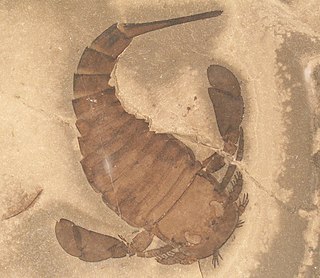
Dekatriata is a clade of planatergan chelicerates including the groups Arachnida, Chasmataspidida, Eurypterida and additionally two stem-genera Winneshiekia and Houia. Dekatriata is defined by an opisthosoma with 13 segments as groundplan and fused, plate-like appendages on the first opisthosomal segment.

Offacolus is an extinct genus of euchelicerate, a group of chelicerate arthropods. Its only species, O. kingi, has been found in deposits from the Silurian period in the Wenlock Series Lagerstätte of Herefordshire, England. It is the only member of the monotypic family Offacolidae, and classified as a basal ("primitive") genus in the clade Euchelicerata, along with Dibasterium and Prosomapoda. The genus is named after Offa, a king from the ancient kingdom of Mercia, and colus, a person who dwelled among the Offa's Dyke. The species name honors Robert Joseph King, a British mineralogist who found the fossils of Offacolus.
